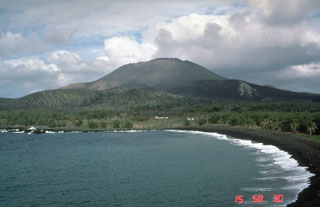Report on Pagan (United States) — September 1981
Scientific Event Alert Network Bulletin, vol. 6, no. 9 (September 1981)
Managing Editor: Lindsay McClelland.
Pagan (United States) New vent in the summit crater
Please cite this report as:
Global Volcanism Program, 1981. Report on Pagan (United States) (McClelland, L., ed.). Scientific Event Alert Network Bulletin, 6:9. Smithsonian Institution. https://doi.org/10.5479/si.GVP.SEAN198109-284170
Pagan
United States
18.13°N, 145.8°E; summit elev. 570 m
All times are local (unless otherwise noted)
"Overflights of Pagan by the USN on 16 July and the USGS on 12 September revealed the formation of a new 60-80-m-diameter crater in the center of the old summit crater. Fume emission rates from the new vent appeared to be significantly greater than the combined rate observed in late May from the three vents formed 15 May. However, no new lava flows were identified and ash accumulation downwind of the new vent was not appreciable. The new vent may have formed during the explosive activity observed from a nearby island 11 June.
Geological Summary. Pagan Island, the largest and one of the most active of the Mariana Islands volcanoes, consists of two stratovolcanoes connected by a narrow isthmus. Both North and South Pagan stratovolcanoes were constructed within calderas, 7 and 4 km in diameter, respectively. North Pagan at the NE end of the island rises above the flat floor of the northern caldera, which may have formed less than 1,000 years ago. South Pagan is a stratovolcano with an elongated summit containing four distinct craters. Almost all of the recorded eruptions, which date back to the 17th century, have originated from North Pagan. The largest eruption during historical time took place in 1981 and prompted the evacuation of the sparsely populated island.
Information Contacts: N. Banks, HVO.

